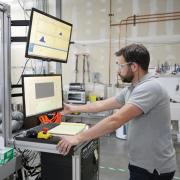
Most particle physics experiments take place in a lab, but these days, JILA professor Dana Anderson prefers taking his to the air. Recently, Anderson and colleagues from his startup company, ColdQuanta, flew a small singlepropeller plane from Boulder to Cheyenne, Wyoming, and back carrying valuable cargo: a modified magneto-optical trap that he and his colleagues developed. This device harnesses a cloud of 10 million individual atoms cooled to near absolute zero and locked in place by lasers. At that ultracold temperature, the atoms take on more fundamental sensitivity and become useful for inertial sensing, which provides information equivalent to an accelerometer and a gyroscope—both essential tools for aviation. Anderson hopes that once the delicate setup can reliably withstand a little turbulence, it could one day supplant GPS as a more accurate navigation system for air travel.







